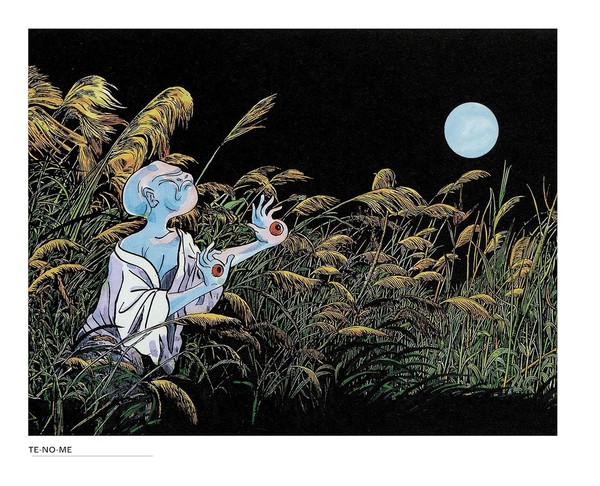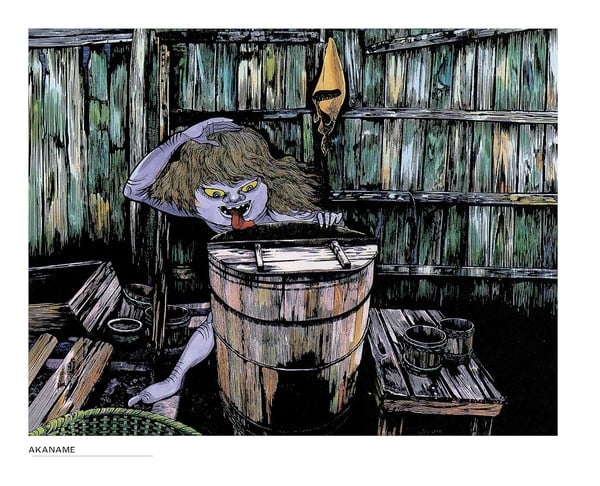Review
by Rebecca Silverman,Yokai: The Art of Shigeru Mizuki
Artbook Review
| Synopsis: |  |
||
This stunning full-color collection of Shigeru Mizuki's yokai paintings includes his notes and thoughts on each folkloric creature, with his own experiences with yokai thrown in occasionally. Yokai: The Art of Shigeru Mizuki is translated by Zack Davisson. |
|||
| Review: | |||
“Shigeru Mizuki,” translator and scholar Zack Davisson says in his introductory essay, “lived in a vibrant fantasy world where every tree, every blade of grass was infused with spiritual energy.” If any one thing comes through in this collection of Mizuki's artwork, it is this – there's a deeply rooted sense of the spiritual and fantastical world overlaying our more mundane one. Each image in Yokai: The Art of Shigeru Mizuki is a vision of a world that, as Mizuki's most famous character Kitaro might say, is hidden in plain sight, a world not perceived by most people, but present nonetheless. Dense backgrounds create a backdrop to more cartoonishly drawn creatures, as if the shadows of nature are hiding the supernatural from our sight. Although nominally an artbook, this might be just as easily described as a collection of folklore. The setup of the volume is that each full-color plate is facing a mostly blank page with a paragraph of information about the yokai depicted on the bottom left. These paragraphs vary in length, never taking up more than a quarter of the facing page, and they tell us about the yokai, where it was first recorded (both in place and in literature), and what it is known for. In a few cases, Mizuki also shares his experiences with what he presumes to be the yokai in question, most typically during his childhood or his deployment in World War Two. Every passage assumes that that yokai truly exist, and this makes it feel as if we're getting a glimpse into the artist's mind, and possibly a front-row seat into how he created his manga.  © 2024 Mizuki Productions There is an impressive variety of yokai collected here, like a real-world version of Natsume's Book of Friends. Two of the most notable aspects of the creatures are the number associated with Okinawa and the sheer amount of kappa variations. Alongside the typical kappa most consumers of Japanese pop culture are familiar with, there are the larger garappa, the even bigger suiko, the undersea ryugu daisenso and their river counterparts suikosama to suijinsama, enko, and tree-dwelling kenmun, whose head dishes contain oil rather than water. From Davisson's introduction, we can extrapolate that this is evidence of living folklore in action – he notes that many yokai were created out of whole cloth or collected by early folklorists and used by enterprising artists to help sell artwork, as there have been several periods where folkloric art was particularly popular in Japan. But it also shows how folklore works in general: a creature or tale is told in different regions or countries that shares marked similarities with those discussed in other places, despite minimal contact between the two. Some of it is simply a game of “telephone,” with an original story being changed as it's passed through many storytellers, while some of it is a case of multiple regions trying to explain something in a way that makes sense to most people. Given that Japan is an island nation, it isn't a stretch to think that kappa, primarily water-based yokai, would be created by different people in different regions and that later interaction would give them shared characteristics. In world folklore, there's a vast amount of water-dwelling fey folk and ghosts that fulfill a similar purpose – explaining deaths on or near the water or offering an explanation for unexpected deaths; some variants of La Llorona (Mexico) involve drowning, while the Scottish bean-nighe (Little Washerwoman) foretells death if you see her washing your clothes by the river, with the Iberian Midnight Washerwomen doing the same with funeral shrouds.  © 2024 Mizuki Productions Other similarities in the volume include a fair amount of “baba,” or old woman, yokai, most of whom are very predatory, which certainly has interesting connotations about the fear of the “crone” stage in the global trinity of maiden, mother, and crone. This, along with Mizuki's recounting of his own yokai experiences, make this a particularly good companion to Mizuki's manga NonNonBâ, also released by Drawn & Quarterly. NonNonBâ (my favorite of his books) is autobiographical, detailing young GeGe (Mizuki's childhood nickname)'s time with her caregiver, an old woman known as NonNonBâ. Much of his fascination with yokai and folklore is said to have come from her, and reading these two books close together substantially enhances both, giving what feels like a more complete image of Mizuki's beliefs and interests in the folkloric supernatural. Davisson notes in his introduction that Mizuki was a very gifted traditional artist, and even his manga backgrounds showed his deft hand with pen and ink, creating a realistic backdrop for his more cartoonish characters. The full-color paintings on display here drive this home beautifully. The depth of the detail is exquisite, with each line feeling meaningful and important to the work as a whole. Characters are a bit less mangafied than in his actual manga (although some yokai, like the kudan, do take on very manga-like characteristics), and his people are generally painted more realistically than in his comic work. A few combine the two styles, such as yuki-onna, and each image is easy to get lost in, with myriad details to draw your eye. A few yokai readers may recognize from GeGeGe no Kitarō also put in appearances, most notably Ittan-Momen (Rollo Cloth) and Nurikabe (Wally Wall).  © 2024 Mizuki Productions If you're a fan of Shigeru Mizuki or Japanese folklore in general, this is a must-have. But even if you're not, it's a fascinating, beautiful book that shows a master at the height of his craft. With an interesting variety of yokai, a solid and informative introduction, and a very personal catalogue of each creature depicted, this is one of the best manga related artbooks I've seen. That may in part be my love of Mizuki's work talking, but even still, it's hard not to enjoy this volume. |
|
The views and opinions expressed in this article are solely those of the author(s) and do not necessarily represent the views of Anime News Network, its employees, owners, or sponsors.
|
| Grade: | |||
Overall : A
+ Beautiful, intricate full-color paintings and interesting yokai information. |
|||
| discuss this in the forum (1 post) | | |||